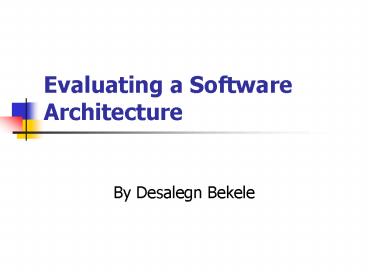Evaluating a Software Architecture PowerPoint PPT Presentation
1 / 17
Title: Evaluating a Software Architecture
1
Evaluating a Software Architecture
- By Desalegn Bekele
2
Evaluating a Software Architecture
- How can you be sure whether the architecture
chosen for your software is the right one? - How can you be sure that it won't lead to
calamity? - Marry your architecture in haste and you can
repent in leisure.Barry Boehm
3
Outline
- What is an Architecture?
- How to validate a software architecture?
- Why Evaluate an Architecture?
- When Can an Architecture Be Evaluated?
- Who's Involved?
- What Are the Outputs of an Architecture
Evaluation? - What Are the Benefits and Costs?
- Conclusion
4
What is an Architecture?
- Is the foundation for any software system.
- will allow or preclude just about all of a
system's quality attributes Modifiability,
performance, security, availability, reliability.
5
How to validate a software architecture?
- A suite of three methods, all developed at the
Software Engineering Institute. - ATAM Architecture Tradeoff Analysis Method
- SAAM Software Architecture Analysis Method
- ARID Active Reviews for Intermediate Designs
6
Architecture Tradeoff Analysis Method (ATAM)
- a structured technique for understanding the
tradeoffs inherent in the architectures of
software-intensive systems. - provides a principled way to evaluate a software
architecture's fitness with respect to multiple
competing quality attributes. - is a spiral model of design one of postulating
candidate architectures followed by analysis and
risk mitigation, leading to refined
architectures.
7
Software Architecture Analysis Method (SAAM)
- aims to predict the quality of a system before it
has been developed. - the quality of the architecture is validated by
analyzing the impact of predefined scenarios on
architectural components. - addresses concerns at the architecture design
level which inherently crosscut multiple
architectural components.
8
Active Reviews for Intermediate Designs (ARID)
- method for reviewing preliminary software designs
(such as for a component or a subsystem) for
suitability in its intended usage context and
environment. - result in a high-fidelity design review coupled
with high-quality familiarization with the design.
9
Why Evaluate an Architecture?
- The cost to fix an error found during
requirements or early design phases is orders of
magnitudes less to correct than error found in
testing. - Architecture determines the structure of the
project schedules and budgets, performance
goals, team structure, documentation
organization, and testing and maintenance
activities.
10
When Can an Architecture Be Evaluated?
- The classical application of architecture
evaluation occurs when the architecture has been
specified but before implementation has begun.
11
When Can an Architecture Be Evaluated?
- Two useful variations from early and late.
- Early - at any stage in the architecture creation
process to examine those architectural decisions
already made and choose among architectural
options. - Late - takes place when the architecture is
nailed down and the implementation is complete.
Mainly used when architecture is inherited from
legacy system.
12
Who's Involved?
- Evaluation team - these are the people who will
conduct the evaluation and perform the analysis. - Stakeholders - stakeholders are people who have a
vested interest in the architecture and the
system.
13
What Are the Outputs of an Architecture
Evaluation?
- Prioritized Statement of Quality Attribute
Requirements. - Having a prioritized statement of the quality
attributes serves as an excellent documentation
record to accompany any architecture and guide it
through its evolution.
14
What Are the Outputs of an Architecture
Evaluation?
- Mapping of Approaches to Quality Attributes.
- produces a mapping that shows how the
architectural approaches achieve (or fail to
achieve) the desired quality attributes.
15
What Are the Outputs of an Architecture
Evaluation?
- Risks and Non-risks.
- Risks are potentially problematic architectural
decisions. - Non-risks are good decisions that rely on
assumptions that are frequently implicit in the
architecture.
16
What Are the Benefits and Costs?
- Forces an Articulation of Specific Quality Goals.
- Results in the Prioritization of Conflicting
Goals. - Puts Stakeholders in the Same Room.
- Improves the Quality of Architectural
Documentation. - Uncovers Opportunities for Cross-Project Reuse.
17
Conclusion
- The average architecture evaluation adds no more
than a few days to the project schedule. - Architecture created in haste will precipitate
disaster performance goals not met, Security
goals falling, customer dissatisfaction, system
that is too hard to change, and schedules and
budgets through the roof.

